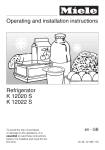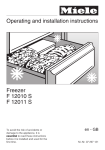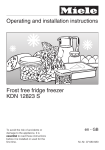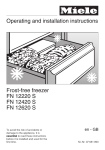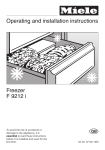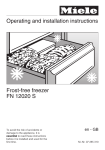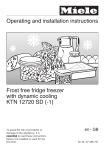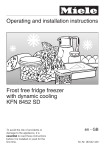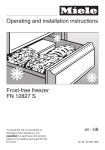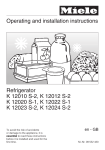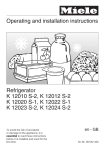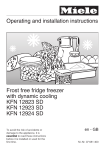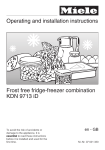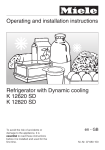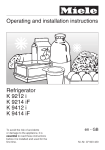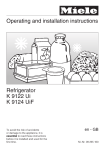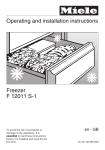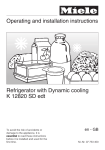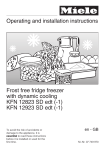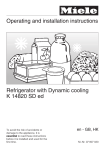Download Miele KT 12510 S
Transcript
Operating and installation instructions Fridge freezer KT 12510 S To avoid the risk of accidents or damage to the appliance, it is essential to read these instructions before it is installed and used for the first time. en - GB M.-Nr. 07 285 490 Contents Guide to the appliance . . . . . . . . . . . . . . . . . . . . . . . . . . . . . . . . . . . . . . . . . . . . . 4 Caring for the environment . . . . . . . . . . . . . . . . . . . . . . . . . . . . . . . . . . . . . . . . . . 6 Warning and Safety instructions . . . . . . . . . . . . . . . . . . . . . . . . . . . . . . . . . . . . . 7 How to save energy . . . . . . . . . . . . . . . . . . . . . . . . . . . . . . . . . . . . . . . . . . . . . . . 12 Switching on and off . . . . . . . . . . . . . . . . . . . . . . . . . . . . . . . . . . . . . . . . . . . . . . 13 Switching off for longer periods of time . . . . . . . . . . . . . . . . . . . . . . . . . . . . . . . . . 13 The correct temperature . . . . . . . . . . . . . . . . . . . . . . . . . . . . . . . . . . . . . . . . . . . 14 . . . in the refrigerator section . . . . . . . . . . . . . . . . . . . . . . . . . . . . . . . . . . . . . . . . . 14 . . . in the freezer section . . . . . . . . . . . . . . . . . . . . . . . . . . . . . . . . . . . . . . . . . . . . 14 Setting the temperature . . . . . . . . . . . . . . . . . . . . . . . . . . . . . . . . . . . . . . . . . . . . . 15 Winter setting . . . . . . . . . . . . . . . . . . . . . . . . . . . . . . . . . . . . . . . . . . . . . . . . . . . . 16 Using the refrigerator efficiently . . . . . . . . . . . . . . . . . . . . . . . . . . . . . . . . . . . . 17 Different storage zones . . . . . . . . . . . . . . . . . . . . . . . . . . . . . . . . . . . . . . . . . . . . . 17 Food which should not be stored in a refrigerator. . . . . . . . . . . . . . . . . . . . . . . . . 17 When shopping for food . . . . . . . . . . . . . . . . . . . . . . . . . . . . . . . . . . . . . . . . . . . . 18 Storing food correctly . . . . . . . . . . . . . . . . . . . . . . . . . . . . . . . . . . . . . . . . . . . . . . 18 Fruit and vegetables . . . . . . . . . . . . . . . . . . . . . . . . . . . . . . . . . . . . . . . . . . . . . 18 Unpacked meats and vegetables . . . . . . . . . . . . . . . . . . . . . . . . . . . . . . . . . . 19 Protein rich foods . . . . . . . . . . . . . . . . . . . . . . . . . . . . . . . . . . . . . . . . . . . . . . . 19 Meat . . . . . . . . . . . . . . . . . . . . . . . . . . . . . . . . . . . . . . . . . . . . . . . . . . . . . . . . . 19 Adjusting the interior fittings . . . . . . . . . . . . . . . . . . . . . . . . . . . . . . . . . . . . . . . 20 Moving the shelves . . . . . . . . . . . . . . . . . . . . . . . . . . . . . . . . . . . . . . . . . . . . . . . . 20 Split shelf . . . . . . . . . . . . . . . . . . . . . . . . . . . . . . . . . . . . . . . . . . . . . . . . . . . . . . . . 20 Adjusting the door shelf/bottle shelf . . . . . . . . . . . . . . . . . . . . . . . . . . . . . . . . . . . 20 Moving the bottle divider . . . . . . . . . . . . . . . . . . . . . . . . . . . . . . . . . . . . . . . . . . . . 20 Freezing and storing food . . . . . . . . . . . . . . . . . . . . . . . . . . . . . . . . . . . . . . . . . . 21 Maximum freezing capacity. . . . . . . . . . . . . . . . . . . . . . . . . . . . . . . . . . . . . . . . . . 21 Freezing fresh food . . . . . . . . . . . . . . . . . . . . . . . . . . . . . . . . . . . . . . . . . . . . . . . . 21 Storing frozen food . . . . . . . . . . . . . . . . . . . . . . . . . . . . . . . . . . . . . . . . . . . . . . . . 21 Home freezing . . . . . . . . . . . . . . . . . . . . . . . . . . . . . . . . . . . . . . . . . . . . . . . . . . . . 22 Hints on home freezing. . . . . . . . . . . . . . . . . . . . . . . . . . . . . . . . . . . . . . . . . . . 22 Packing . . . . . . . . . . . . . . . . . . . . . . . . . . . . . . . . . . . . . . . . . . . . . . . . . . . . . . . 22 Before placing food in the freezer section . . . . . . . . . . . . . . . . . . . . . . . . . . . . 23 Placing food in the freezer section . . . . . . . . . . . . . . . . . . . . . . . . . . . . . . . . . . 23 Defrosting . . . . . . . . . . . . . . . . . . . . . . . . . . . . . . . . . . . . . . . . . . . . . . . . . . . . . . . 23 Ice cubes . . . . . . . . . . . . . . . . . . . . . . . . . . . . . . . . . . . . . . . . . . . . . . . . . . . . . . . . 24 Cooling drinks . . . . . . . . . . . . . . . . . . . . . . . . . . . . . . . . . . . . . . . . . . . . . . . . . . . . 24 Contents Defrosting . . . . . . . . . . . . . . . . . . . . . . . . . . . . . . . . . . . . . . . . . . . . . . . . . . . . . . . 25 Refrigerator section . . . . . . . . . . . . . . . . . . . . . . . . . . . . . . . . . . . . . . . . . . . . . . . . 25 Freezer section . . . . . . . . . . . . . . . . . . . . . . . . . . . . . . . . . . . . . . . . . . . . . . . . . . . 25 Cleaning and care . . . . . . . . . . . . . . . . . . . . . . . . . . . . . . . . . . . . . . . . . . . . . . . . 27 Cleaning the outer casing, the interior and accessories . . . . . . . . . . . . . . . . . . . . 27 Ventilation gaps . . . . . . . . . . . . . . . . . . . . . . . . . . . . . . . . . . . . . . . . . . . . . . . . . . . 28 Door seals . . . . . . . . . . . . . . . . . . . . . . . . . . . . . . . . . . . . . . . . . . . . . . . . . . . . . . . 28 Problem solving guide . . . . . . . . . . . . . . . . . . . . . . . . . . . . . . . . . . . . . . . . . . . . 29 Noises . . . . . . . . . . . . . . . . . . . . . . . . . . . . . . . . . . . . . . . . . . . . . . . . . . . . . . . . . 32 After Sales / Guarantee . . . . . . . . . . . . . . . . . . . . . . . . . . . . . . . . . . . . . . . . . . . . 33 Electrical connection . . . . . . . . . . . . . . . . . . . . . . . . . . . . . . . . . . . . . . . . . . . . . . 34 Electrical connection U.K. . . . . . . . . . . . . . . . . . . . . . . . . . . . . . . . . . . . . . . . . . . . 34 Installation . . . . . . . . . . . . . . . . . . . . . . . . . . . . . . . . . . . . . . . . . . . . . . . . . . . . . . 35 Location . . . . . . . . . . . . . . . . . . . . . . . . . . . . . . . . . . . . . . . . . . . . . . . . . . . . . . . . . 35 Climate range . . . . . . . . . . . . . . . . . . . . . . . . . . . . . . . . . . . . . . . . . . . . . . . . . . 35 Ventilation . . . . . . . . . . . . . . . . . . . . . . . . . . . . . . . . . . . . . . . . . . . . . . . . . . . . . . . 35 Installation . . . . . . . . . . . . . . . . . . . . . . . . . . . . . . . . . . . . . . . . . . . . . . . . . . . . . . . 35 Aligning the appliance . . . . . . . . . . . . . . . . . . . . . . . . . . . . . . . . . . . . . . . . . . . . . . 36 Appliance dimensions . . . . . . . . . . . . . . . . . . . . . . . . . . . . . . . . . . . . . . . . . . . . . . 37 Changing the door hinging . . . . . . . . . . . . . . . . . . . . . . . . . . . . . . . . . . . . . . . . . 38 Building in the appliance . . . . . . . . . . . . . . . . . . . . . . . . . . . . . . . . . . . . . . . . . . 41 Guide to the appliance a On/Off and temperature selector b Winter setting switch 4 c Light contact switch Guide to the appliance a Freezer section shelf b Butter and cheese compartment c Refrigerator shelves d Door shelf/Egg tray e On/Off and temperature selector, interior lighting and winter setting switch f Condensate channel and drain hole g Fruit and vegetable containers h Bottle divider* i Bottle shelf * Depending on model 5 Caring for the environment Disposal of the packing material The transport and protective packing has been selected from materials which are environmentally friendly for disposal, and can normally be recycled. Ensure that any plastic wrappings, bags etc. are disposed of safely and kept out of the reach of babies and young children. Danger of suffocation! Disposal of your old appliance Electrical and electronic appliances often contain materials which, if handled or disposed of incorrectly, could be potentially hazardous to human health and to the environment. They are, however, essential for the correct functioning of your appliance. Please do not therefore dispose of your old appliance with your household waste. Rather than just throwing these materials away, please ensure that they are recycled. Please dispose of it at your local community waste collection / recycling centre or contact your dealer for advice. Ensure that it presents no danger to children while being stored for disposal. It should be unplugged or disconnected from the mains electricity supply by a competent person. Take care not to damage the pipework at the back of it before or during transportation to an authorised collection depot. In this way, refrigerant in the pipework and oil in the compressor will be contained, and will not leak out into the environment. 6 Warning and Safety instructions Correct application This appliance complies with all relevant local and national safety requirements. Improper use can, however, present a risk of both personal injury and material damage. To avoid the risk of accidents and damage to the appliance, please read these instructions carefully before installation and before using it for the first time. They contain important notes on the installation, safety, operation and care of the appliance. Keep these instructions in a safe place and pass them on to any future user. ~ This appliance is intended for domestic use only for the cool storage of food and drink as well as for storing deep frozen food, freezing fresh food and for preparing ice. Any other usage is not supported by the manufacturer and could be dangerous. The manufacturer cannot be held liable for damage resulting from incorrect or improper use or operation. ~ This appliance is not intended for use by persons (including children) with reduced physical, sensory or mental capabilities, or lack of experience and knowledge, unless they are supervised whilst using it, or have been shown how to use it by a person responsible for their safety. Safety with children ~ This appliance is not a toy! To avoid the risk of injury, do not allow children to play with it or near it, or to play with the controls. Neither should they be allowed to swing on the door. Please supervise young children whilst you are using it. Older children may only use the appliance when its operation has been clearly explained to them and they are able to use it safely, recognising the dangers of misuse. 7 Warning and Safety instructions Technical safety ~ Before setting up the appliance, check it for any externally visible damage. Do not install and use a damaged appliance. A damaged appliance is dangerous. ~ If the connection cable is faulty it must only be replaced by a service technician authorised by the manufacturer to protect the user from danger. ~ This appliance contains the coolant Isobutane (R600a), a natural gas which is environmentally friendly. Although it is flammable, it does not damage the ozone layer and does not increase the greenhouse effect. The use of this coolant has, however, led to a slight increase in the noise level of the appliance. In addition to the noise of the compressor, you might be able to hear the coolant flowing around the system. This is unavoidable, but does not have any adverse effect on the performance of the appliance. Care must be taken during the transportation and installation of the appliance that no parts of the cooling system are damaged. Leaking coolant can damage the eyes. In the event of any damage: - avoid open flames and anything which creates a spark, - disconnect from the mains, - air the room in which the appliance is located for several minutes and - contact the Service Department for advice. 8 ~ The more coolant there is in an appliance, the larger the room it should be installed in. In the event of a leakage, if the appliance is in a small room, there is the danger of combustible gases building up. For every 8 g of coolant at least 1 m3 of room space is required. The amount of coolant in the appliance is stated on the data plate inside the appliance. ~ Safe operation of the appliance is only assured if it has been installed and connected in accordance with these operating and installation instructions. ~ Before connecting the appliance, make sure that the connection data on the data plate (voltage and connected load) match the mains electricity supply. This data must correspond in order to avoid the risk of damage to the appliance. Consult a qualified electrician if in any doubt. ~ Do not connect the appliance to the mains electricity supply by a multi-socket unit or an extension lead. These do not guarantee the required safety of the appliance (e.g. danger of overheating). Warning and Safety instructions ~ The electrical safety of this appliance can only be guaranteed when continuity is complete between it and an effective earthing system which complies with current local and national safety regulations. It is most important that this basic safety requirement is present and tested regularly, and where there is any doubt, the household wiring system should be inspected by a qualified electrician. The manufacturer cannot be held liable for damage or injury caused by the lack of or inadequacy of an effective earthing system (e.g. electric shock). ~ The appliance must be isolated from ~ Installation, maintenance and – the screw-out fuse has been removed (in countries where this is applicable). repairs may only be carried out by a suitably qualified and competent person in strict accordance with current national and local safety regulations. Repairs and other work by unqualified persons could be dangerous. The manufacturer cannot be held liable for unauthorised work. ~ While the appliance is under guarantee, repairs should only be undertaken by a service technician authorised by the manufacturer. Otherwise the guarantee will be invalidated. the electricity supply during installation, maintenance and repair work. The appliance is only completely isolated from the electricity supply when: – it has been switched off at the socket and the plug has been withdrawn, or – the fuse from the fused spur connection unit has been withdrawn, or – the mains fuse has been disconnected, or ~ Faulty components must only be replaced by genuine Miele original spare parts. The manufacturer can only guarantee the safety of the appliance when Miele replacement parts are used. ~ This appliance may only be used in mobile installations such as ships, if a risk assessment of the installation has been carried out by a suitably qualified engineer. ~ In countries where there are areas which may be subject to infestation by cockroaches or other vermin, pay particular attention to keeping the appliance and its surroundings in a clean condition at all times. Any damage which may be caused by cockroaches or other vermin will not be covered by the guarantee. 9 Warning and Safety instructions Correct use ~ Never handle frozen food with wet hands. Your hands may freeze to the frozen food. Danger of frost burn. ~ Do not take ice cubes out with your bare hands and never place ice cubes or ice lollies in your mouth straight from the freezer. The very low temperature of the frozen ice or lollies can cause frost burn to the lips and tongue. ~ Do not refreeze thawed or partially thawed food. Defrosted food should be used up as quickly as possible, as food soon loses its nutritional value and goes off. Defrosted food may only be re-frozen after it has been cooked. ~ Do not store explosive materials in the appliance or any products containing propellants (e.g. spray cans). Thermostats switching on may produce sparks which could present a fire hazard. Flammable compounds could explode. ~ Do not operate any electrical equipment (e.g. an electric ice-cream maker) inside the appliance. Danger of sparking and explosion. ~ If storing alcohol with a high percentage proof, make sure it is tightly closed and stored upright. Danger of explosion. 10 ~ Do not store cans or bottles containing carbonated drinks or liquids which could freeze in the freezer. The cans or bottles could explode. Danger of injury and damage to the appliance. ~ When cooling drinks quickly in the freezer, make sure bottles are not left in for more than one hour; otherwise they could burst, resulting in injury or damage. ~ Observe the "use by" dates given on food to avoid the risk of food poisoning. Storage times will depend on several factors, including the freshness and quality of the food as well as the temperature at which it is stored. Follow the instructions given on the food manufacturer's packaging regarding storage conditions and "use-by" dates. ~ Do not use sharp edged objects to – remove frost and ice, – separate frozen foods and remove ice trays. They will damage the evaporator, causing irreversible damage to the appliance. ~ Do not place electric heaters or candles in the appliance to defrost it. These can damage the plastic parts. Warning and Safety instructions ~ Do not use defrosting sprays or de-icers, as they might contain substances which could damage the plastic parts or which could cause the build-up of gases and pose a danger to health. Disposal of your old appliance ~ Before disposing of an old appliance, first make the door latch or lock unusable. This way you will prevent children from accidentally locking themselves in and endangering their lives. ~ Do not use any oils or grease on the door seals, as these will cause the seals to deteriorate and become porous with time. ~ Be careful not to damage any part of ~ Do not store cooking oil in the refrigerator door. Traces of oil can cause stress cracks to occur in the plastic components in the door. – puncturing the refrigerant channels in the evaporator. ~ Do not block the ventilation gaps in the appliance as this would impair the efficiency of the appliance, increase the electricity consumption and could cause damage to the appliance. ~ The appliance is designed for use within certain climate ranges (ambient temperatures), and should not be used outside this range. The climate range for your appliance is stated on the data plate inside the appliance. Installing it in a room with too low an ambient temperature, e.g. a garage, can lead to the appliance switching off for longer periods so that it cannot maintain the required temperature. the pipework whilst awaiting disposal, e.g. by – bending any pipework. – scratching the surface coating. Splashes of refrigerant can damage the eyes. The manufacturer cannot be held liable for damage caused by non-compliance with these Warning and Safety instructions. ~ Do not use a steam-cleaning appliance to defrost or clean this appliance. Steam could reach the electrical components and cause a short circuit. 11 How to save energy Normal energy consumption Increased energy consumption In a ventilated room. In an enclosed, unventilated room. Protected from direct sunlight. In direct sunlight. Not situated near to a heat source (radiator, oven). Situated near to a heat source (radiator, oven). Where the ideal ambient room temperature is approx. 20°C. Where there is a high ambient room temperature. Temperature setting with a thermostat which is approximate (set in stages). With a medium setting of 2 to 3. With a high setting: the lower the temperature in the compartment, the higher the energy consumption. Temperature setting with a thermostat which is exact to the degree (digital display). Cellar section 8 to 12°C Installation site On appliances with winter setting, please make sure that the winter PerfectFresh zone just above 0 °C setting is switched off when the ambient temperature is warmer Freezer section -18°C than 16 °C. Refrigerator section 4 to 5 °C Wine storage section 10 to 12 °C Use Only open the doors when necessary and for as short a time as possible. Frequent opening of the doors for long periods will cause a loss of coldness. Store food in an organised way. If food is not stored in an organised way, searching for an item will mean the door is open for longer. Allow hot food and drinks to cool down before placing them in the appliance. Placing hot food in the appliance will cause the compressor to run for a long time, as the appliance will have to work harder to lower the temperature. Store food covered or packaged. The evaporation or condensation of liquids will cause a loss of coldness in the refrigerator. Place frozen food in the refrigerator to defrost. Do not over-fill the appliance to allow air to circulate. Defrosting 12 Defrost the freezer compartment when a layer of ice 0.5 cm thick has built up. A layer of ice hinders the cold from reaching the frozen food, and causes an increase in energy consumption. Switching on and off Before using for the first time Switching off The stainless steel trim to the interior shelves and the door shelves has a layer of protective foil to prevent scratching during transportation. ^ Turn the On/Off and temperature selector in an anti-clockwise direction from "1" back to the "0" position. You will meet a little resistance, but this should be ignored. ^ Clean the inside of the appliance and the accessories with lukewarm water and a little washing-up liquid, and then dry with a soft cloth. ^ Carefully remove the protective foil from the stainless steel trim. Important: To ensure the correct functioning of the appliance, let it stand for between 1½ and 2 hours after transporting it to its final location before connecting it to the mains. Switching on ^ Turn the On/Off and temperature selector in a clockwise direction away from the "0" position. The higher the setting, the lower the temperature in the appliance. The appliance will start cooling and the interior light in the refrigerator section will come on if you open the door. To enable the temperature to get sufficiently cold inside the appliance, allow the appliance to run for a few hours before placing food in it. The interior light will not come on when you open the door and the cooling process will be switched off. Switching off for longer periods of time If the appliance is not going to be used for a longer period of time, e.g. whilst on holiday: ^ switch the appliance off, ^ switch off at the wall socket and withdraw the plug, ^ defrost the freezer section, ^ clean the appliance out and ^ leave the doors ajar to air the appliance. If, during a long absence, the appliance is switched off but not cleaned out and the doors are left shut, there is a danger of mould and odours building up inside the appliance. 13 The correct temperature It is very important to set the correct temperature for storing food in the appliance. Micro-organisms will cause food which is not stored at the correct temperature to deteriorate rapidly. Temperature influences the growth rate of these micro-organisms. Reducing the temperature reduces their growth rate. – bathwater and other household thermometers are not very accurate. It is best to use an electronic thermometer. – Do not measure the temperature of the air in the appliance. The result will not reflect the temperature in the food. – the more often the door is opened and the longer it is kept open, – Try to open the door as little as possible during the measuring period, as warm room air will enter the refrigerator every time the door is opened. – if too much food is stored in it at once, . . . in the freezer section The temperature in the appliance will rise: – the warmer the food is which is being put into it, – the higher the ambient temperature surrounding the appliance. The appliance is designed for use in specific ambient temperatures (climate ranges). Do not use in ambient temperatures for which it is not designed. . . . in the refrigerator section We recommend a temperature of 4 °C in the middle of the refrigerator section. If you wish to check the temperature in the refrigerator section, ^ place a thermometer in a glass of water and then place the glass in the middle of the refrigerator section. After about 24 hours, the thermometer will show the approximate temperature in the refrigerator section. Please note the following: 14 To freeze fresh food and to store frozen food for a long time, a temperature of -18 °C is required. At this temperature the growth of micro-organisms is generally halted. As soon as the temperature rises above -10 °C, the micro-organisms become active in the food again so that it cannot be kept as long. For this reason, partially defrosted or defrosted food must not be re-frozen. Food may be re-frozen once it has been cooked, as the high temperatures achieved when cooking destroy most micro-organisms. The correct temperature Setting the temperature The temperature is set with the On/Off and temperature selector. ^ Turn it to a setting between 1 and 7. The higher the setting, the lower the temperature in the appliance. A middle range setting is usually sufficient. However, if frozen food is to be stored in the freezer section then a setting of between 4 and 7 is recommended to ensure that the required temperature in the freezer section is maintained. It is also advisable to set the temperature within this range, if – the doors are opened frequently, – large quantities of food are stored inside the appliance, – there is a high ambient temperature. 15 Winter setting With very low ambient temperatures at or below 16 °C the freezer section may not be able to maintain its temperature. The low room temperature may prevent the appliance from running often enough, resulting in frozen food beginning to thaw. The winter setting is designed to prevent this happening. To activate the winter setting ^ Press the switch for the winter setting to "1". The refrigerator will switch on more frequently, lowering the temperature in the freezer section to the required level. 16 To deactivate the winter setting As soon as the ambient temperature rises above 16 °C , the winter setting should be switched off. ^ Press the switch for the winter setting to "0". The appliance will continue running at normal power. Using the refrigerator efficiently Different storage zones Due to the natural circulation of the air in the appliance, there are different temperature zones in the refrigerator. Cold, heavy air sinks to the lowest section of the appliance. Make use of the different zones when placing food in the appliance. Warmest area The warmest area is in the top section of the door. Use this for storing butter and cheese. Do not store explosive materials in the appliance or any products containing propellants (e.g. spray cans). Danger of explosion. If storing alcohol with a high percentage proof, make sure it is tightly closed, and store upright. Do not store cooking oil in the refrigerator door. Traces of oil can cause stress cracks to occur in the plastic components in the door. Coldest area The coldest area in a refrigerator is directly above the vegetable containers. Use this for all delicate and highly perishable food, e.g. – fish, meat, poultry, – sausage products, ready meals, – dishes or baked goods containing eggs or cream, – fresh dough, cake mixtures, pizza or quiche dough, – soft cheese and other dairy products, – pre-packed vegetables and other fresh food with a label stating it should be kept at a temperature of approx. 4 °C. Food must not touch the back wall of the appliance, as it may freeze to the back wall. Food which should not be stored in a refrigerator Not all food is suitable for refrigeration. This includes: – Fruit and vegetables which are sensitive to cold, such as bananas, avocado, papaya, passion fruit, aubergines, peppers, tomatoes and cucumbers – Fruit which is not yet ripe – Potatoes – Some hard cheeses, e.g. Parmesan 17 Using the refrigerator efficiently When shopping for food Fruit and vegetables The freshness of food when first placed in the appliance is an important factor in determining how long it stays fresh. Time out of the refrigerator e.g. during transportation should be kept to a minimum. For example, do not allow food to stay in a hot car for too long. Once food has started to deteriorate, this process cannot be reversed. As little as two hours outside the refrigerator can cause food to start deteriorating. Fruit and vegetables may be stored loose in the vegetable containers. However, you should bear in mind that aromas and flavours can transfer from one type of food to another (e.g. carrots absorb the smell and flavour of onions very easily). Some food also gives off a natural gas (ethylene) which speeds up the rate at which other food perishes. Some fruit and vegetables react strongly to this gas and should not be stored together. Storing food correctly – Examples of fruit and vegetables which produce a large amount of this natural gas are: Store food covered or packaged. This will prevent food smells from affecting other foods, food from drying out, and also any cross-contamination of bacteria. The growth of bacteria, such as salmonella, can be avoided by setting the correct temperature and maintaining good standards of hygiene. Apples, apricots, pears, nectarines, peaches, plums, avocado, figs, blueberries, melons and beans. – Examples of fruit and vegetables which react strongly to the natural gases given off by other types of fruit and vegetables are: Kiwis, broccoli, cauliflower, Brussels sprouts, mangos, honeydew melons, apples, apricots, cucumbers, tomatoes, pears, nectarines and peaches. Example: Broccoli should not be stored with apples, as apples produce a large amount of natural gas to which broccoli is very sensitive. The result is a shorter than expected storage time for the broccoli. 18 Using the refrigerator efficiently Unpacked meats and vegetables Unpackaged meat and vegetables should be stored separately. To avoid any microbiological cross-contamination, these foods may only be stored together if they are wrapped. Protein rich foods Please note that foods rich in protein deteriorate faster than others. Shellfish, for example, deteriorates faster than fish, and fish deteriorates faster than meat. Meat Meat should be stored unwrapped. (Undo wrappings slightly to leave meat loosely covered, and leave containers open). This permits air to circulate around the meat, allowing the surface to dry slightly, which helps prevent the growth of bacteria. To prevent the risk of bacterial cross-contamination, do not let meat come into direct contact with other foods. 19 Adjusting the interior fittings Moving the shelves The shelves can be adjusted according to the height of the food. ^ Raise the shelf, and pull it forwards slightly until the notch at the side is in line with the shelf support. It can then be raised or lowered to the required level. The raised edge at the back must face upwards to prevent food from touching the back of the appliance and freezing to it. Stoppers prevent the shelves from being dislodged by mistake. Split shelf In order to accommodate tall items in the appliance, one of the shelves is divided. The front section can be pushed under the rear section. ^ Pull the front half of the glass shelf forwards slightly and then push it carefully under the rear half. To move the split shelf: ^ Take both halves of the split glass shelf out, ^ fit the two brackets onto the supports on either side at the required height, ^ and push the glass shelves in one after the other. The shelf with the raised edge must be at the back. Adjusting the door shelf/bottle shelf ^ Push the door/bottle shelf upwards, then remove it by pulling it forwards. ^ Replace the door/bottle shelf at the required position. Ensure that it is securely pushed back into position. Moving the bottle divider (depending on model) The bottle divider can be moved to the left or right to ensure that bottles are held securely in position when the door is opened and shut. The bottle divider can be removed completely (e.g. for cleaning). ^ To do this, push up the front edge of the bottle divider, and disengage it. 20 Freezing and storing food Maximum freezing capacity Storing frozen food To ensure that fresh food placed in the freezer section freezes through to the core as quickly as possible, the maximum freezing capacity must not be exceeded. The maximum freezing capacity for freezing within a 24-hour period is given on the data plate “Freezing capacity ....kg/24 hrs”. When buying frozen food to store in your freezer section, check The maximum freezing capacity given on the data plate has been calculated according to DIN EN ISO 15502 Standard. Freezing fresh food Fresh food should be frozen as quickly as possible. This way the nutritional value of the food, its vitamin content, appearance and taste are not impaired. Food which takes a long time to freeze will lose more water from its cells, which then shrink. During the defrosting process, only some of this water is reabsorbed by the cells; the rest collects around the food. – that the packaging is not damaged, – the use-by date, – the temperature at which the frozen food is being stored in the shop. The length of time it can be kept is reduced if it has been stored at a temperature warmer than -18 °C. ^ Buy frozen food once you have finished the rest of your shopping, and wrap it in newspaper or use a cool bag or cool box to transport it. ^ Store it in the freezer section as soon as possible. Never re-freeze partially or fully defrosted food. Consume defrosted food as soon as possible as it will lose its nutritional value and spoil if left for too long. Defrosted food may only be re-frozen after it has been cooked. If food is frozen quickly, the cells have less time to lose moisture, so they shrink less. As there is not so much moisture, it is easier for the food to reabsorb it during the defrosting process, and very little water collects around the defrosted food. 21 Freezing and storing food Home freezing Only freeze fresh food which is in a good condition. Hints on home freezing – The following types of food are suitable for freezing: Fresh meat, poultry, game, fish, vegetables, herbs, fresh fruit, dairy products, pastry, leftovers, egg yolks, egg whites and a range of pre-cooked meals. – The following types of food are not suitable for freezing: Grapes, lettuce, radishes, sour cream, mayonnaise, eggs in their shells, onions, whole raw apples and pears. – To retain colour, taste and vitamin C, vegetables should be blanched after they have been trimmed and washed. To blanch: bring a large saucepan of water to the boil and immerse the vegetables in the fast boiling water for 2-3 minutes, depending on variety. Remove, and plunge into ice-cold water to cool quickly. Drain and pack ready for freezing. – Lean meat freezes better than fatty meat, and can be stored for considerably longer. – To prevent chops, steaks, cutlets or rolled meat from freezing together in solid blocks when packed, separate with a sheet of plastic freezer film. – Do not season fresh foods or blanched vegetables before freezing. Only season cooked food 22 lightly before freezing, but care should be taken as the taste of some spices alters when frozen. – Do not place hot food or drinks in the freezer. This causes already frozen food to thaw and increases the energy consumption considerably. Allow hot food and drinks to cool down before placing them in the freezer. Packing ^ Freeze food in portions. Suitable packing material - plastic freezer film - freezer bags - freezer containers - aluminium foil Unsuitable packing material - wrapping paper - grease-proof paper - cellophane - bin liners - plastic carrier bags ^ Expel as much air as possible from bags etc. before sealing them, to prevent freezer-burn on food. ^ Close the packaging tightly with - rubber bands - plastic clips - string or bag ties - freezer tape. Freezer bags may also be sealed using home heat-sealing kits. ^ Make a note of the contents and the date of freezing on the packaging. Freezing and storing food Before placing food in the freezer section ^ Turn the temperature selector to a middle or high setting for approx. 24 hours before placing food in the freezer section. ^ The winter setting should also be switched on some time before placing the food in the freezer section (see "Winter setting"). This helps food that is already in the freezer section to stay frozen. Placing food in the freezer section ^ Place the food flat in the bottom of the freezer section so that it freezes through to the core as quickly as possible. ^ Make sure that the packaging and containers are dry to prevent them sticking together when frozen. When freezing, make sure that food already frozen does not come into contact with fresh food being frozen as this could cause the frozen food to begin to defrost. ^ Turn the temperature selector to a lower setting approx. 24 hours after placing food in the freezer section. ^ Switch off the winter setting if the ambient room temperature is above 16°C. Defrosting Frozen food can be defrosted in different ways: – in a microwave oven, – in an oven using the "Fan" or "Defrost" setting, – at room temperature, – in the refrigerator (the cold given off by the frozen food helps to keep other food cold), – in a steam oven. Poultry It is particularly important to observe food hygiene rules when defrosting poultry. Do not use the liquid from defrosted poultry. Pour it away and wash the container it was in, the sink and your hands. Danger of salmonella poisoning. Fruit should be defrosted at room temperature in its packaging, or in a covered bowl. Most vegetables can be cooked while still frozen. Just put straight into boiling water or hot fat. The cooking time is slightly less than that of fresh vegetables due to changes in the cell structure. Never re-freeze partially or fully defrosted food. Consume defrosted food as soon as possible as it will lose its nutritional value and spoil if left for too long. Defrosted food may only be re-frozen after it has been cooked. 23 Freezing and storing food Ice cubes Fill the ice tray three quarters full with water and place it at the bottom of the freezer section. Once frozen, use a blunt instrument, for example a spoon handle, to remove the ice tray from the freezer section. Ice cubes can be removed easily from the tray by twisting the tray gently or by holding it under cold running water for a short while. Cooling drinks When cooling drinks quickly in the freezer section, make sure bottles are not left in the freezer section for more than one hour, as they could burst. 24 Defrosting Refrigerator section Freezer section The refrigerator defrosts automatically. The freezer section does not defrost automatically. Condensate and frost can build up on the back wall of the refrigerator section whilst it is in use. You do not need to remove this, as it will defrost and evaporate automatically with the warmth generated by the appliance. The condensate is drained away via a channel and drain hole into an evaporation system at the back of the appliance. Ensure that the condensate channel and drain hole are kept clean and are never blocked so that condensate can flow away without hindrance. In normal use, ice and frost will form on the evaporator. If allowed to accumulate, this will impair the efficiency of the freezer section and increase the consumption of electricity. Do not scrape ice and frost off the evaporator as this can damage it and render the appliance unusable. The freezer section should be defrosted from time to time. It must be defrosted if a layer of ice approx. 0.5 cm thick has accumulated. It is best to defrost when only very little food or no food at all is left in the appliance. Before defrosting ^ Remove the frozen food from the freezer section and place it in another freezer or cool box, or wrap it in several layers of newspaper or cloths, ^ and store it in a cool place until the freezer section is ready for use again. 25 Defrosting To defrost Carry out the defrosting procedure as quickly as possible if food has not been placed in another freezer. The longer the food is left out at room temperature, the faster it defrosts. ^ Switch the appliance off at the wall socket and remove the plug. ^ Open the freezer section door. ^ Use a sponge or towel to soak up the defrosted water. To speed up defrosting, a bowl with hot water (not boiling) can be placed on a saucer in the freezer section. Closing the door in this instance will help retain warmth and speed up the defrosting process. We do not recommend the use of hot air blowers such as hairdryers for defrosting your freezer. Never place electric heaters or candles in the appliance to defrost it. These can damage the plastic parts. Do not use defrosting sprays or de-icers, as they could contain substances which may damage the plastic parts and which may cause a build-up of gases and pose a danger to health. 26 After defrosting ^ Clean the appliance, and then dry it thoroughly. Do not let water get into the condensate channel and drain hole. ^ Insert the plug in the appliance, and switch the appliance back on. ^ Once the temperature in the freezer section has reached the required temperature, place the food back in the freezer section. Cleaning and care Before cleaning A range of Miele branded cleaning and conditioning agents is available from the Miele Spare Parts Department, or via the internet on www.miele-shop.com. Never use cleaning agents containing abrasive substances such as sand, soda, acids or chemical solvents. "Non-abrasive" cleaning agents are also unsuitable as they can cause matt areas to appear. Do not let water get into the temperature selector, the light or the ventilation gaps. Do not let water get into the drainage channel and drain hole when cleaning. Never use steam cleaning apparatus to defrost or clean the appliance. Steam could reach the electrical components and cause a short circuit. The data plate located inside the appliance must not be removed. It contains information which is required in the event of a service call. ^ Switch the appliance off by turning the temperature selector to "0" and then switching off at the socket and removing the plug. ^ Take any food out of the appliance and store it in a cool place. ^ Defrost the freezer section. ^ Take out any removable parts, e.g. shelves, for cleaning. Cleaning the outer casing, the interior and accessories ^ Clean the refrigerator section at least once a month and the freezer section each time it is defrosted. Use warm water with a little washing up liquid. ^ Accessories and shelves should all be hand-washed only. ^ Clean the condensate channel and drain hole frequently, so that condensate can drain away unhindered. Use a straw or similar to clear the drain if necessary. ^ After cleaning wipe the outer casing, interior and accessories with a damp cloth and dry with a soft cloth. Leave the doors open to air the appliance for a short while. 27 Cleaning and care Ventilation gaps After cleaning ^ The ventilation gaps should be cleaned on a regular basis with a brush or vacuum cleaner. A build up of dust will increase the energy consumption of the appliance. ^ Replace all shelves and accessories in the appliance. Metal grille at the back of the appliance ^ Place food back in the appliance and close the doors. The metal grille at the back of the appliance (heat exchanger) should be dusted at least once a year. A build-up of dust will increase the energy consumption of the appliance. ^ When cleaning the grille, make sure that the pipework and other components do not get broken or damaged in any way. Door seals Do not use any oils or grease on the door seals as these will cause the seals to deteriorate and become porous over time. The door seals should be cleaned regularly with clean water and then wiped dry with a soft cloth. 28 ^ Insert the plug and switch on at the wall socket. Switch the appliance on with the temperature selector. Problem solving guide Repairs to electrical appliances should only be carried out by a suitably qualified and competent person in strict accordance with current local and national safety regulations. Repairs and other work by unqualified persons could be dangerous. The manufacturer cannot be held liable for unauthorised work. Some minor problems can be corrected without contacting Miele. What to do if . . . . . . the appliance does not get cool. ^ Make sure that the On/Off and temperature selector is not set at "0". ^ Check that the plug is correctly inserted into the socket and switched on. ^ Check that the fuse is not defective and that the mains fuse has not tripped. If it has, contact the Miele Service Department. the refrigerator section to fall automatically. For this reason, do not exceed the maximum quantity of food that can be frozen at once - see the data plate. ^ Has the winter setting been switched on? . . . the appliance is switching in too frequently and for too long. ^ Check whether the ventilation gaps have been covered over or become dusty. ^ Check whether the metal grille (heat exchanger) at the back of the appliance has become too dusty. ^ The doors have been opened too frequently, or a large amount of fresh food has been put in at once for freezing. ^ Check that the doors have been closed properly. ^ Check to see whether a thick layer of ice has built up in the freezer section. If it has, then the freezer section will need defrosting. . . . the temperature in the refrigerator is too low. ^ Turn the On/Off and temperature selector to a warmer setting. ^ Check that the freezer section door has been closed properly. ^ Has a large amount of fresh food been frozen at the same time? This makes the compressor run for longer, causing the temperature in 29 Problem solving guide . . . the frozen food is thawing because the freezer section is too warm. ^ Is the room temperature lower than the ambient temperature for which the appliance is designed? If so, raise the temperature of the room. Operating in a room which is too cold will cause the cooling system to switch off for too long, causing the freezer section to become too warm. . . . the interior lighting in the refrigerator section is not working. ^ First check whether the light contact switch is sticking or the On/Off and temperature selector is at "0". If neither is not the case, then the lamp is defective. ^ Disconnect the appliance from the mains. Switch off at the wall and withdraw the plug from the socket, or disconnect the mains fuse or remove the screw-out fuse in countries where this is applicable. ^ On appliances that have winter setting, switch the winter setting on (see "Winter setting"). . . . food has frozen together. Use a blunt instrument, e.g. a spoon handle or plastic scraper, to prise it apart carefully. . . . there is a thick layer of ice in the freezer section. ^ Check whether the freezer section door closes properly. ^ Defrost and then clean the freezer section. Too thick a layer of ice reduces efficiency and increases energy consumption. ^ Reach under the back of the light cover, and pull the cover off. ^ Remove the lamp and replace with a new one. Lamp specification: 220 - 240 V, E 14 fitting See the old lamp for the Wattage required. ^ Replace the cover. 30 Problem solving guide . . . the interior light cover is warm even though the door has not been opened for a while This is not a fault. This appliance is equipped with a winter setting. If the ambient temperature surrounding the appliance drops to below 16 °C, and the winter setting is not switched on, the compressor will run less often causing the freezer section to become too warm. With the winter setting switched on, the interior light will come on automatically, even with the door closed, if the ambient temperature surrounding the appliance drops below 16 °C. This warms up the temperature inside the refrigerator section. . . . the floor of the refrigerator is wet. The drain hole is blocked. ^ Clean the condensate channel and drain hole. If you still cannot remedy the fault having followed these suggestions, please contact the Miele Service Department. To prevent unnecessary loss of temperature, it is advisable not to open the doors while waiting for the appliance to be serviced. The warmth created by the light being on causes the compressor to start up more frequently and thus lower the temperature in the freezer section again. Please be aware that the appliance will not work properly if the ambient temperature drops below 10°C, even with the winter setting switched on. If this happens you will need to increase the ambient temperature in the room in which the appliance is installed. 31 Noises Normal noises What causes them Brrrrr... Humming noise made by the motor (compressor). This noise can get louder for brief periods when the motor is switching on. Blubb, blubb.... A gurgling noise can be heard when coolant is circulating through the pipes. Click.... Clicking sounds are made when the thermostat switches the motor on and off. Sssrrrrr.... On multi-zone and frost-free appliances you can sometimes just hear the movement of air circulating inside the appliance. Remember that the noise of the compressor and the coolant circulating in the system is unavoidable. Noises that you can easily rectify What causes them, and what can you do about them? Rattling, vibrating The appliance is uneven: Realign the appliance using a spirit level, by raising or lowering the screw feet underneath the appliance. The appliance is touching another appliance or piece of furniture: Move it away. Drawers, baskets or shelves are unstable or sticking: Check all removable items and refit them correctly. Are any bottles or containers unstable or knocking against each other? Separate them. The transport cable clips are hanging loose at the back of the appliance: Remove the clips. 32 After Sales / Guarantee In the event of a fault which you cannot correct yourself, or if the appliance is under guarantee, please contact: – your Miele Dealer or Chartered Agent or – the Miele Service Department (see back cover for contact details). When contacting your Dealer/Chartered Agent or Miele, please quote the model and serial number of your appliance. This information is given on the data plate inside your appliance. Please note that telephone calls may be monitored and recorded for training purposes. Guarantee For information on the appliance guarantee specific to your country please contact Miele. See back cover for contact details. In the U.K. your appliance is guaranteed for 2 years from the date of delivery. However, you must activate your cover by calling 08706 080028 or registering online at www.miele.co.uk. 33 Electrical connection Electrical connection U.K. Non-rewireable plugs (BS 1363) All electrical work should be carried out by a suitably qualified and competent person in strict accordance with current local and national safety (BS 7671 in the UK). The fuse cover must be re-fitted when changing the fuse, and if the fuse cover is lost, the plug must not be used until a suitable replacement is obtained. The colour of the correct replacement cover is that of the coloured insert in the base of the plug, or the colour that is embossed in words in the base of the plug (as applicable to the design of the plug fitted). The appliance is supplied with a mains cable and moulded plug ready for connection to an a.c. single phase 220-240 V 50 Hz supply. The voltage and frequency are given on the data plate. Please ensure that these match the household mains supply. The fuse rating is quoted on the plug. Connection should be made via a suitable switched socket which is easily accessible. For extra safety it is advisable to install a suitable residual current device (RCD). Do not connect the appliance to the mains electricity supply by an extension lead. Extension leads do not guarantee the required safety of the appliance (e.g. danger of overheating). The appliance must not be connected to an inverter and must not be used with a plug adapter as these can cause damage to the appliance’s electronic unit. 34 Replacement fuses should be ASTA approved to BS 1362 and have the correct rating. Replacement fuses and fuse covers may be purchased from your local electrical supplier. WARNING THIS APPLIANCE MUST BE EARTHED Installation Do not place any appliance which gives off heat, such as a toaster or microwave oven, on top of this appliance, as this would increase the appliance's energy consumption. This appliance must not be installed directly next to another refrigerator or freezer. It does not have side-wall heating, so installation next to another refrigerator or freezer could cause a build-up of condensation between them. Further information is available from your dealer. Location This appliance should be installed in a dry, well-ventilated room. It should not be installed where it is exposed to direct sunlight or directly adjacent to a heat-producing appliance such as an oven or a radiator. The room temperature should not go above or below the climate range for which the appliance is designed. The higher the ambient temperature of the room, the more energy the appliance requires to operate. Climate range Climate range Ambient room temperature SN N ST T SN-ST SN-T +10°C to +32°C +16°C to +32°C +16°C to +38°C +16°C to +43°C +10°C to +38°C +10°C to +43°C Operating in a room which is too cold will result in the cooling system switching off for too long, causing the internal temperature in the appliance to rise with the risk of frozen food deteriorating and going off. Ventilation Air at the back of the appliance gets warm. To ensure sufficient ventilation, the ventilation gaps must not be covered over. The air inlet and outlet must not be covered or blocked in any way. They should be dusted on a regular basis. Installation ^ Remove the cable clip from the back of the appliance. ^ Check that all parts at the back of the appliance are unhindered. Carefully remove any hindrance. ^ Carefully push the appliance into position with the back against the wall. The appliance is designed for use within certain climate ranges (ambient temperatures), and should not be used outside this range. The climate range of the appliance is stated on the data plate inside the appliance. 35 Installation Aligning the appliance ^ To align the appliance, adjust the feet using the spanner supplied. 36 Installation Appliance dimensions KT 12510 S A B C 1570 mm 550 mm 628 mm 37 Changing the door hinging The appliance is supplied right hand hinged. If left hand door hinging is required, follow the instructions below. It is essential that the changing of the door hinging is carried out by two people. In the following illustration the doors are not shown in the closed position to make it easier to see what happens next. ^ Close the lower appliance door. ^ With the upper door closed, pull hinge pin e downwards to remove it. ^ Open the upper door carefully, and pull it downwards and off. ^ Take care not to lose the washers. ^ Remove cover f, and unscrew hinge bracket g. ^ Refit bracket h and cover i turned through 180° on the opposite side. ^ Undo screw a on the lower door bearing b. ^ Open the lower door carefully, and pull it upwards and off. ^ Take hinge pin c out of the door bearing and place to to one side. ^ Unscrew door bearing b and screw it into position on the opposite side. ^ Remove cover d and refit on the opposite side. 38 ^ Screw hinge bracket g into the opposite side. Changing the door hinging ^ Unscrew hinge pin j and fit it into the neighbouring hole in the hinge bracket. ^ Turn cover f through 180°, and fit it on the other side. ^ Remove stoppers k, and unscrew hinge bracket l. ^ Turn hinge bracket l through 180° and screw into position on the opposite side. ^ Refit stoppers k on the opposite side. ^ Remove the stoppers from the door bearing bushes in the doors and refit on the opposite side. ^ Hang the upper door on hinge pin j and then close the appliance door. ^ Push hinge pin e with the longer section at the top from below into hinge bracket l in the upper door. ^ Fit hinge pin c from below into the lower door. ^ Slowly close the lower door. As you do so hinge pin c will slide into the guides on the side of door bearing b. ^ Secure hinge pin c by fitting screw a into the door bearing. ^ Hang the lower appliance door on hinge pin e. 39 Changing the door hinging Changing over the door handle ^ Carefully remove cover a and stoppers b from the sides using a flatheaded screwdriver. ^ Turn the handle 180° and fit to the opposite side. ^ First screw it at the side and then in the middle g. ^ Push cover c to the left by placing a suitable wooden or plastic tool d in the groove on the right hand side. ^ In the same way, replace cover a and stoppers b on the opposite side. ^ Carefully remove cover c. ^ Replace centre cover c by engaging it first on the left and then on the right hand side. Be careful not to let the tool slip, causing damage to the appliance. ^ Loosen screws e on the handle side and in the middle, and remove handle f. 40 Building in the appliance The air inlet and outlet must not be covered or blocked in any way. They should be dusted on a regular basis. When installed next to a wall d a distance of approx. 30 mm is needed on the hinge side between the wall d and the appliance b, so that the doors have sufficient space for opening. When securing to adjoining furniture or if a spacer is fitted between the appliance and the wall, please note the following: ^ Check that the doors can be opened. a Top box b Appliance c Housing unit d Wall The appliance can be installed in a kitchen run. To match the height of the rest of the kitchen, the appliance can be fitted with a suitable top box a. ^ Do not drill within the greyed out area (see diagram) as this would damage insulated parts of the appliance. ^ Secure the appliance to the adjoining kitchen furniture unit using self-tapping screws. The maximum depth you can screw into the refrigerator is 10 mm. Do not exceed this amount. A ventilation gap of at least 50 mm depth must be allowed for behind the appliance for air to circulate. The cross section of the air outlet under the room ceiling must be at least 300 cm2 to ensure that air can circulate without hindrance. Otherwise the appliance has to work harder, resulting in an increase in electricity consumption. 41 42 43 Alteration rights reserved / 1708 KT 12410 S M.-Nr. 07 285 490 / 01












































